Historic Admiralteysky is known for its gilded palaces, sprawling cathedrals and immense neo-baroque architecture. And thanks to a younger generation of Russians, the St Petersburg neighbourhood is seeing a reinvigoration of its food, art, design and cultural charms.
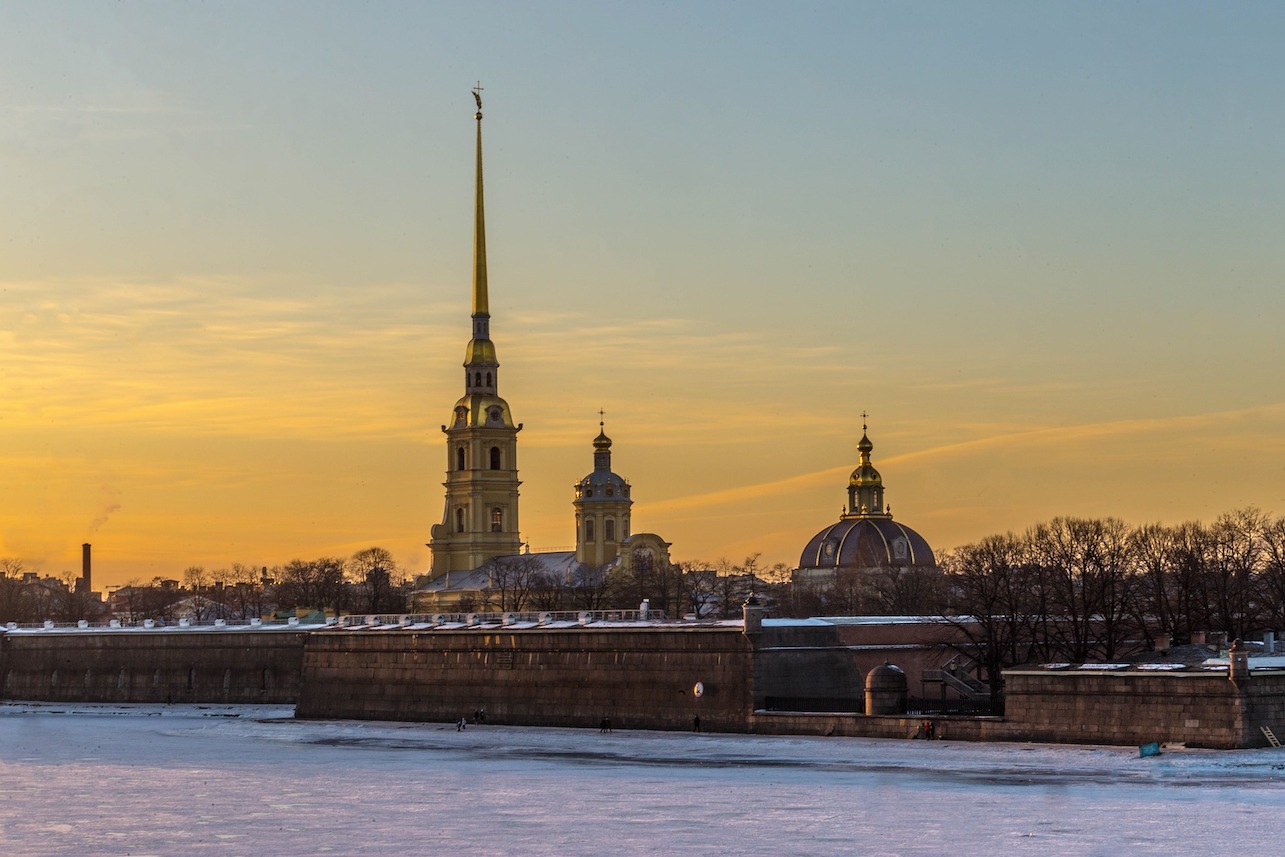
The gilded compass spire of the Admiralty building (Photo: Luidmila Kot via Pixabay)
Culturally speaking, Admiralteysky is home to some of St Petersburg’s most impressive sights. This is where Peter the Great built his great Baltic fleet, and there’s an impressive legacy of landmarks, statues and street names to prove it. Add to this impressive historical hit-list a burgeoning gastronomy scene, lively nightlife and vibrant network of quirky home-grown ateliers, and you’re presented with one of the city’s most fascinating neighbourhoods.
Culture Fix
Most people arrive in Admiralteysky by metro – blinking and bewildered – having travelled up a (125-metre) 410-foot escalator from the abysses of Russia’s deepest metro station. Look to the horizon and head straight for the gilded spire of the Admiralty Building (Admiralteyskiy Proyezd, 1), a helpful compass point for the city. Peter the Great ordered construction of the fortified shipyard in 1704 and it remained the headquarters of the Russian navy until 1917. Today, it’s the largest naval college in the country.
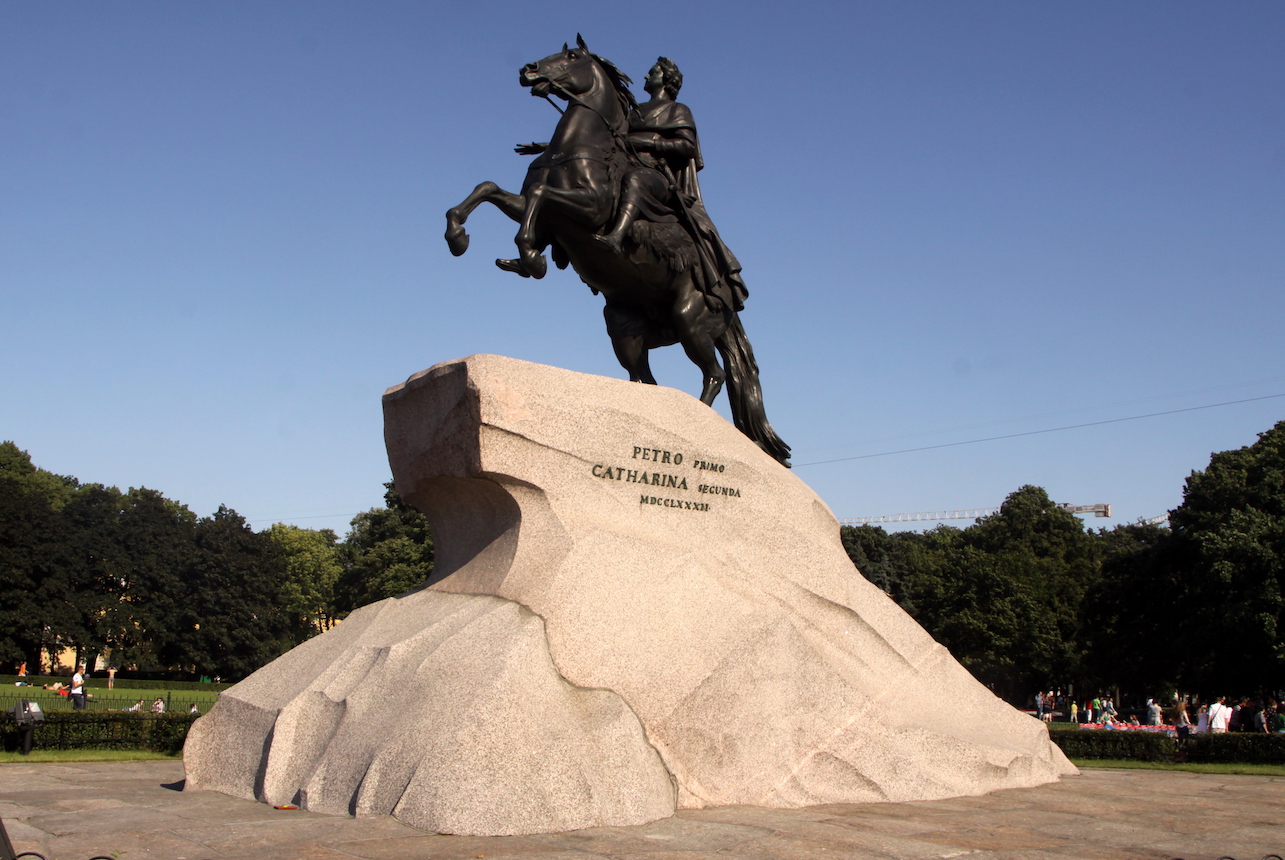
The Bronze Horseman (Photo: Retlaw Snellac Photography via Flickr / CC BY 2.0)
A few steps away is The Bronze Horseman (Senate Sq.), immortalised by Pushkin’s epic poem of the same name. The 13.7-metre (45-foot) statue was ordered built by Catherine the Great as a tribute to her predecessor and is inscribed – lest anyone forget who paid for it – “To Peter I from Catherine II”. As well as jostling against actors dressed in full Peter the Great and Catherine the Great garb, visitors often find themselves part of a merry wedding party, since it’s also a traditional spot for wedding day photos.
Not far from here is St Isaac’s Cathedral (St Isaac’s Sq.), one of St. Petersburg’s best-known buildings. Construction began in 1818, but it took some forty years to complete. Understandable, once you step inside and take in the 600m² of mosaics, 14 different types of marble and 818m² frescoed ceiling. It took more than 100kg of gold leaf to cover its iconic gilded cupolas alone. Climb the 262 steps of the kolonnada for sweeping views of the city.
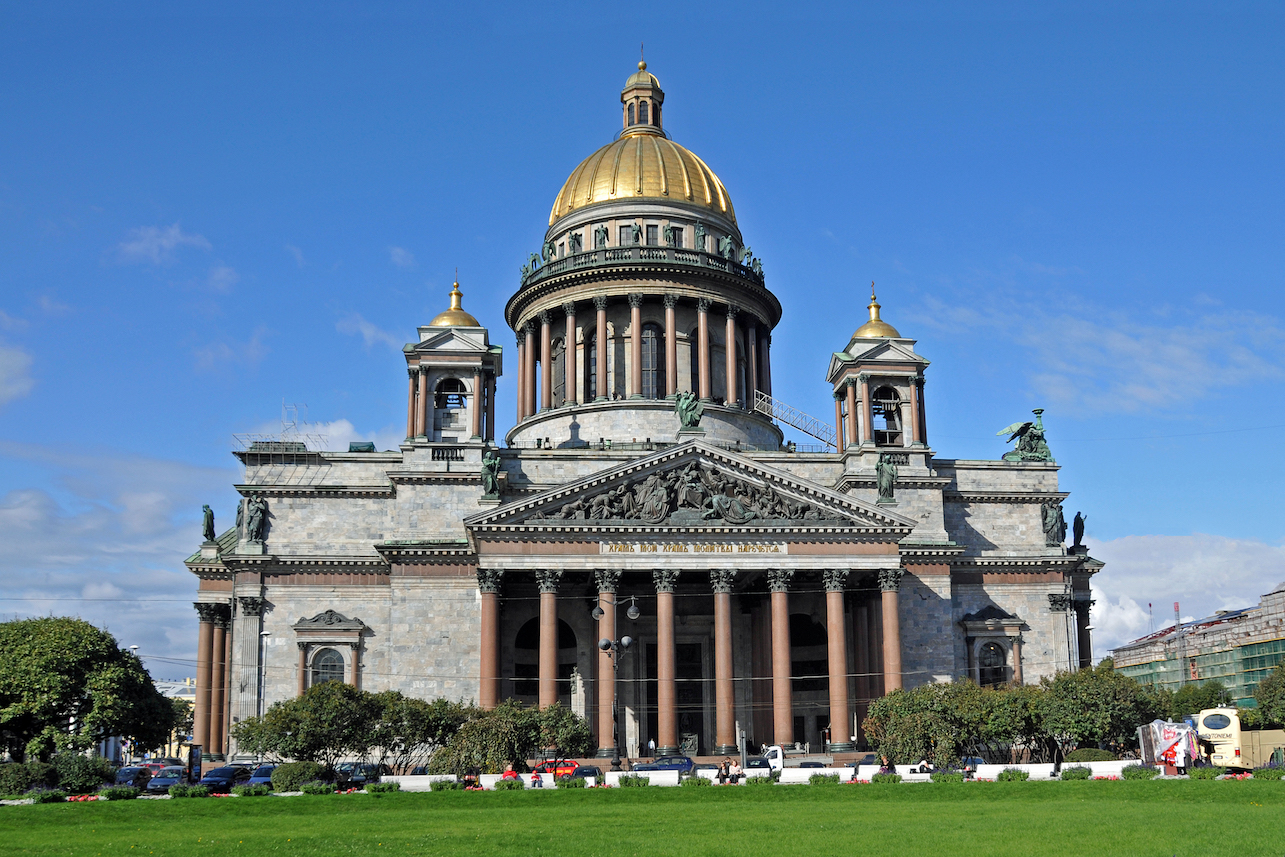
The gilded domes of St Isaac’s Cathedral (Photo: Dennis Jarvis via Flickr / CC BY-SA 2.0)
A ten-minute walk west of the cathedral is Yusupov Palace (Ulitsa Dekabristov, 21А). The state rooms, art galleries and rolling exhibition programme are impressive, but the palace is best known for its affiliation with Russia’s most notorious priest. It was here that a group of conspirators, disturbed by Rasputin’s sinister influence on the Royal Household, assassinated him. Visitors can trundle down to the basement museum to learn about how the evening unfolded, assisted by an audio guide and life-size replicas of the aristocrats involved.
When gilt-induced visual fatigue inevitably hits, The Museum of Russian Vodka (Konnogvardeyskiy Bul’var, 4) is the perfect pit-stop. The small, private museum tells the story of Russia’s favourite tipple, from bread wine to Smirnoff. The whimsical collection of bottles, stoppers, photographs and equipment is enchanting, but since most of the descriptions are in Russian, the audio tour is highly recommended. Plus, the price includes an authentic vodka tasting, featuring five different vodkas and an assortment of typical Russian aperitives – tiny herring, slithers of lard on toast and pickled cucumbers – to nibble on.
Where to eat
As a nation that has, for decades, had almost no international culinary profile to speak of, it may come as a surprise that St Petersburg has anything to offer beyond borscht. But, in the past few years, a quiet food revolution has been taking place in the city, in part due to the U.S. and European food sanctions. Lacking products from overseas, chefs have started looking closer to home, reviving old cooking techniques and recipes, and re-branding unfashionable Russian ingredients.
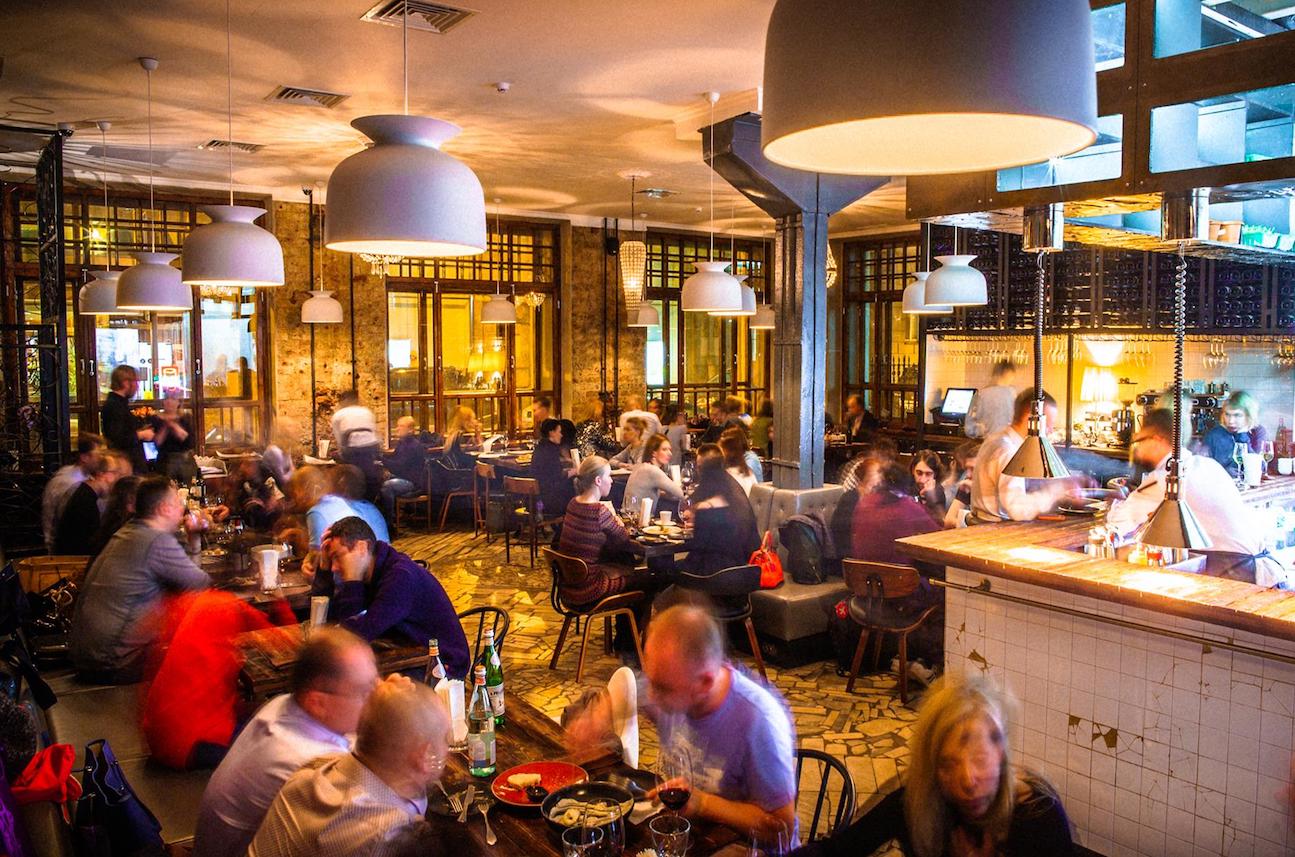
Hamlet+Jacks is always humming with activity (Photo: Hamlet+Jacks)
One of those restaurants pushing the boundaries of Russian cuisine is Hamlet+Jacks (Volynskiy Pereulok, 2), a modestly-sized restaurant off the Moyka river. Hailed as one of the country’s most exciting chefs, Evgeny Vikentev is shaking up the scene with adventurous but unpretentious dinners. Visitors can choose from two separate menus: ‘Ours’ or ‘Ours + Theirs’. The salmon tala, a menu favourite, is served exactly as Siberian fishermen have eaten it for centuries: cut into tiny frozen chunks that melt on the tongue.
For traditional Russian fare at an affordable price, few places are as charming as Idiot (embankment river Moyka, 82). Stepping into the dimly-lit basement restaurant is like sliding headfirst into a Chekhov set. Walls are lined with striped burgundy wallpaper, ageing photographs of old generals and rows of Russian novels. The lengthy menu features all the great Russian stalwarts: herrings in fur coats, blinchiki pancakes and pillowy pelmini, the Russian equivalent of ravioli. The staff hasn’t changed for more than a decade either, another reason visitors return again and again.
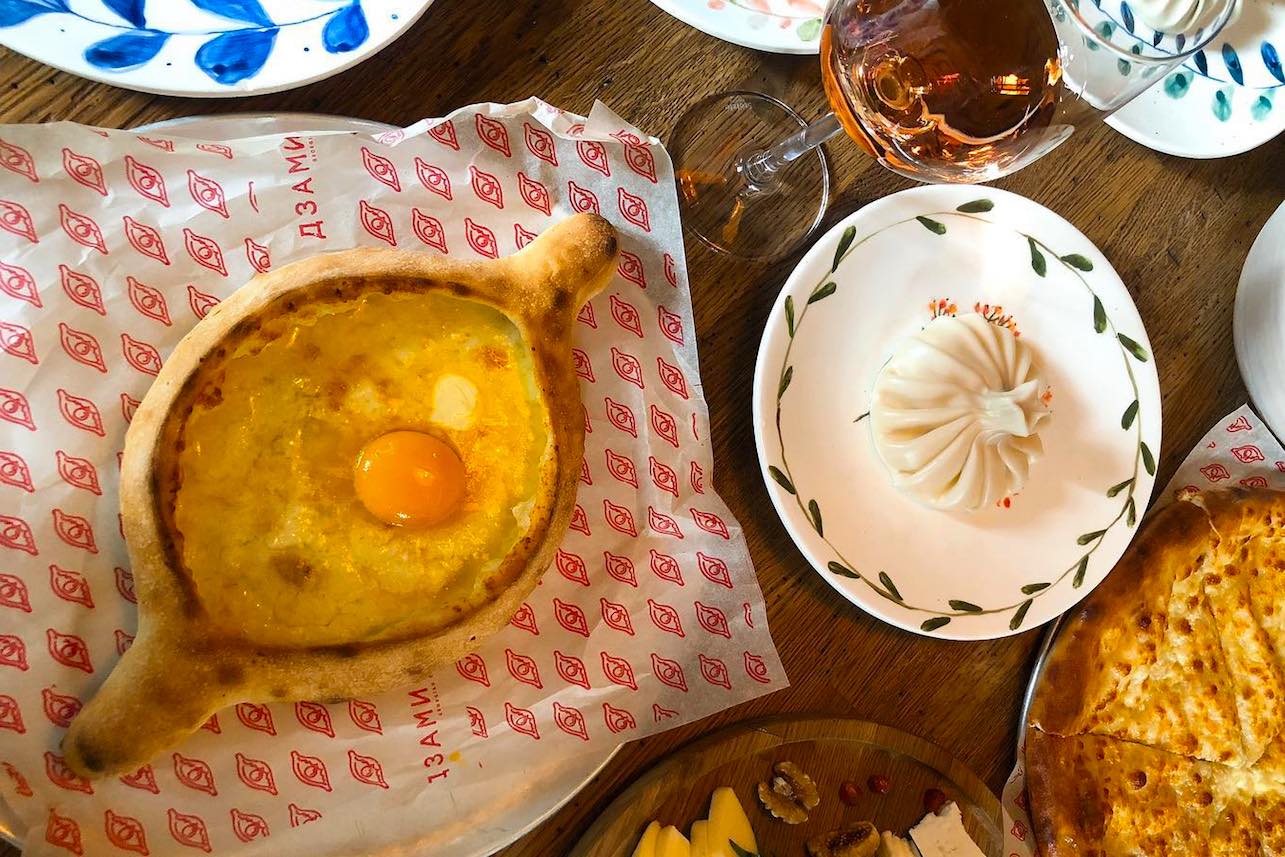
An authentic cheese-laden khachapuri at Dzamiko (Photo: Dzamiko)
Like other modern European cities, St. Petersburg is home to hundreds of international restaurants but, despite diplomatic tensions, Georgian is by far the most popular. There are heaps of highly reputable Georgian restaurants in Admiralteysky, but one of the best is Dzamiko (Naberezhnaya Admiralteyskogo Kanala, 2А), near Yusupov Palace. Order hot, spicy soups called kharcho and the khachapuri, a vat of melted cheese encased in sweet bread and topped with a single yellow golden yolk. Comfort food to warm your cockles.
Shopping
Au Pont Rouge (embankment river Moyka, 73) offers old-school department store thrills away from the city’s main commercial artery, the Nevsky Prospekt. The style moderne building, constructed in 1906, was the first multi-storey store in Russia and was once considered the most fashionable place to be seen. Still stylish – though admittedly more accessible – you’ll find clothes, accessories and souvenirs. Visitors can take a tour of the recently restored glass cupola too.
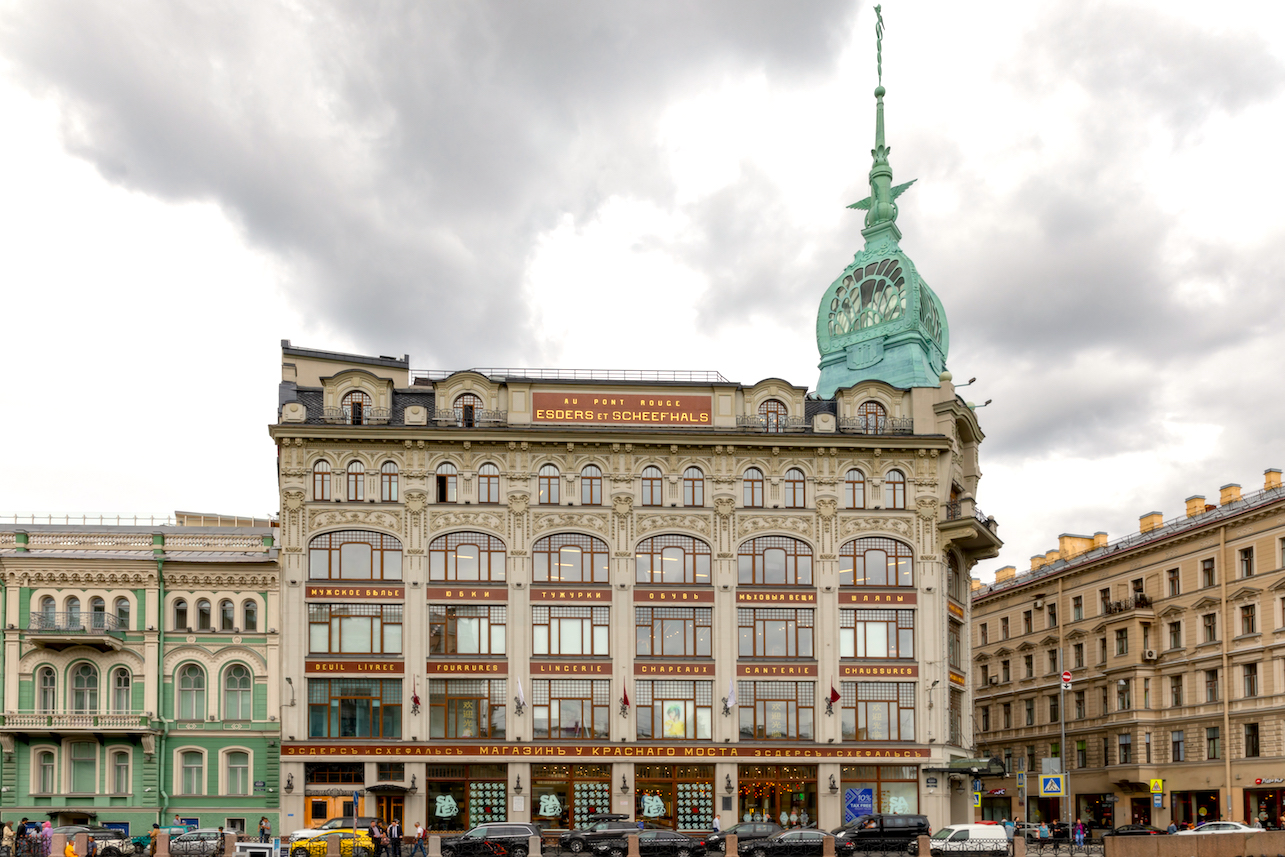
Au Pont Rouge is the oldest department store in St Petersburg (Photo: Ninara via Flickr / CC BY 2.0)
Among the roster of independent boutiques in Admiralteysky, Unique Fabrique (Gorokhovaya St, 24) stands out for its dedication to local brands and upcoming local designers. The thoughtfully-curated collection features names like Chereshnya, almost exclusively made from natural materials like hemp. The walls are covered from floor to ceiling in intricately-detailed powder blue tiles while shelves are lined with terrariums and cacti, giving the effect of an old-world dressing room.
Tucked away in an unassuming passage off Gorokhovaya Street, Pimp Your Eyes (Griboyedov Channel Embankment, 1) describes itself as ‘the new format optics’. Offering expertise in both eye health and design, visitors can get an eye test, followed by a brand-new bespoke pair of frames. Staff are passionate and knowledgeable about the products, and will happily share the story of each and every frame, from concept to creation. With interiors designed by Facultative Works, the premises feels more high-end concept store than opticians.
After hours
St. Petersburg may not be able to compete with Moscow’s fashionable nightclubs and sprawling all-night dance floors but there are plenty of places to let your hair down. Taking its cues from Europe, Admiralteysky nightlife ranges from dimly-lit whisky bars and speakeasies to swanky roof terrace cocktail bars.
Get your bearings by heading to the HI SO Terrace (Voznesensky Ave, 6). This glamorous roof terrace offers sweeping views of St. Petersburg’s skyline, right in front of St Isaac’s gilded domes. Out on the terrace a stylish bar serves up innovative – if slightly pricey – cocktails. A nifty casing around the terrace ensures breeze-free nights all year round. The bar frequently hosts international DJ sets at the weekends too.
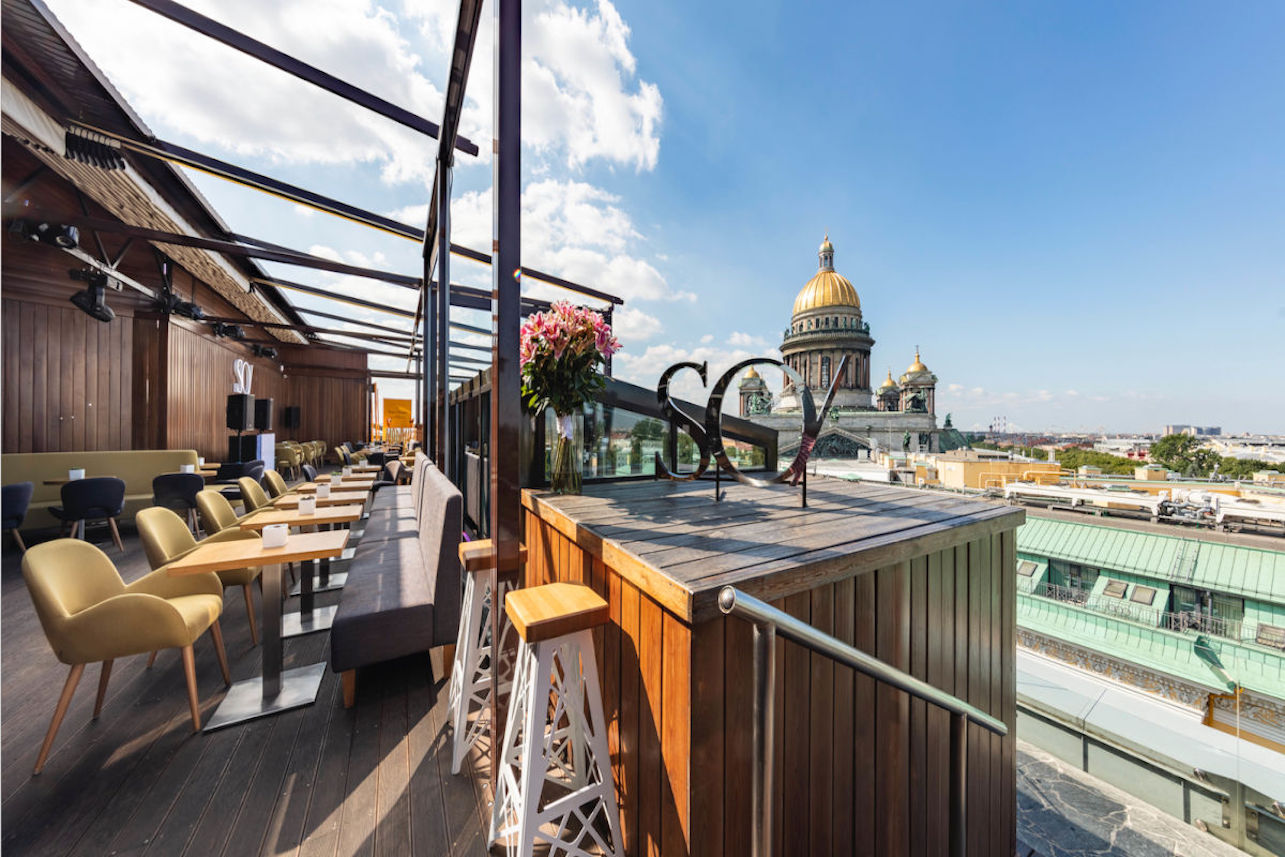
Impressive city views at the HI SO Terrace Bar (Photo: SO St Petersburg)
If you’ve only got the stamina for one destination, make it Kuznya House at New Holland House (Naberezhnaya Admiralteyskogo Kanala, 2А), the beating heart of the island’s social and cultural scene. Once upon a time, this 19-acre multi-purpose venue protected the city from Peter the Great’s enemies. Today, the UNESCO heritage site offers boutiques, cafes, work spaces, galleries, landscaped parks and playgrounds, and a premier ice skating rink in the winter. Kuznya House is the former foundry, now a restaurant and club. Inside, an electric maze of rooms are fully reconstructed with brick vaulted ceilings, stone staircases and furnished with velvet and lacquer. By night, the main hall is cleared of furniture and DJs get behind the decks.
If you prefer your entertainment a little more high-brow and your nights to wrap up by 10:30pm, there’s the spectacular Mariinsky Theatre (Theatre Sq.). All of Russia’s greatest artists have performed on its stage: Nureyev, Pavlova, Nijinkshy, and many of Tchaikovsky’s most famous works premiered there too. Home to the Russian ballet and opera since the 1860s, performances take place throughout the year. Tickets must be purchased in advance as they sell out quickly. During the White Nights, the theatre is part of the Stars of the White Nights Festival, the largest international music festival in the country.
Hotels
With dozens of accommodation options, from budget hostels to luxury hotels, and B&Bs to studio apartments, finding accommodation in Admiralteysky is a relatively pain-free experience.
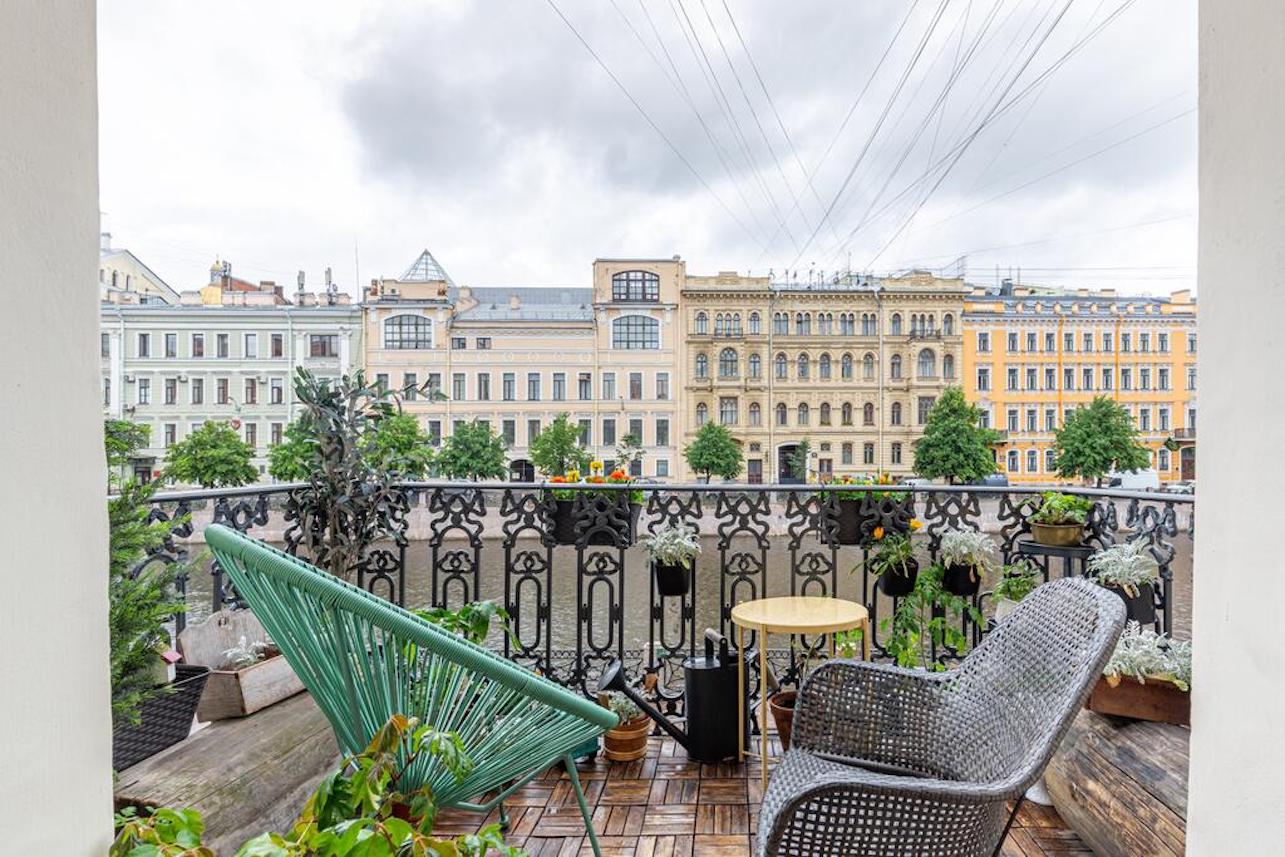
A pretty terrace at Soho Kitchen Hostel (Photo: Soho Kitchen)
Soul Kitchen (embankment river Moyka, 62/2) is a beautiful boho boutique hostel, housed in a building dating back to 1863. They offer a wide range of rooms, from eight-bed female-only dorms to private double bedrooms with period fireplaces. Common areas are thoughtfully laid out, with a spacious kitchen, large TV lounge and friendly reception. In the summer, visitors can head outdoors to the small terrace for an aperitif. Thoughtful extras, like free city maps and discounts at local cafes and bars, go a long way too.
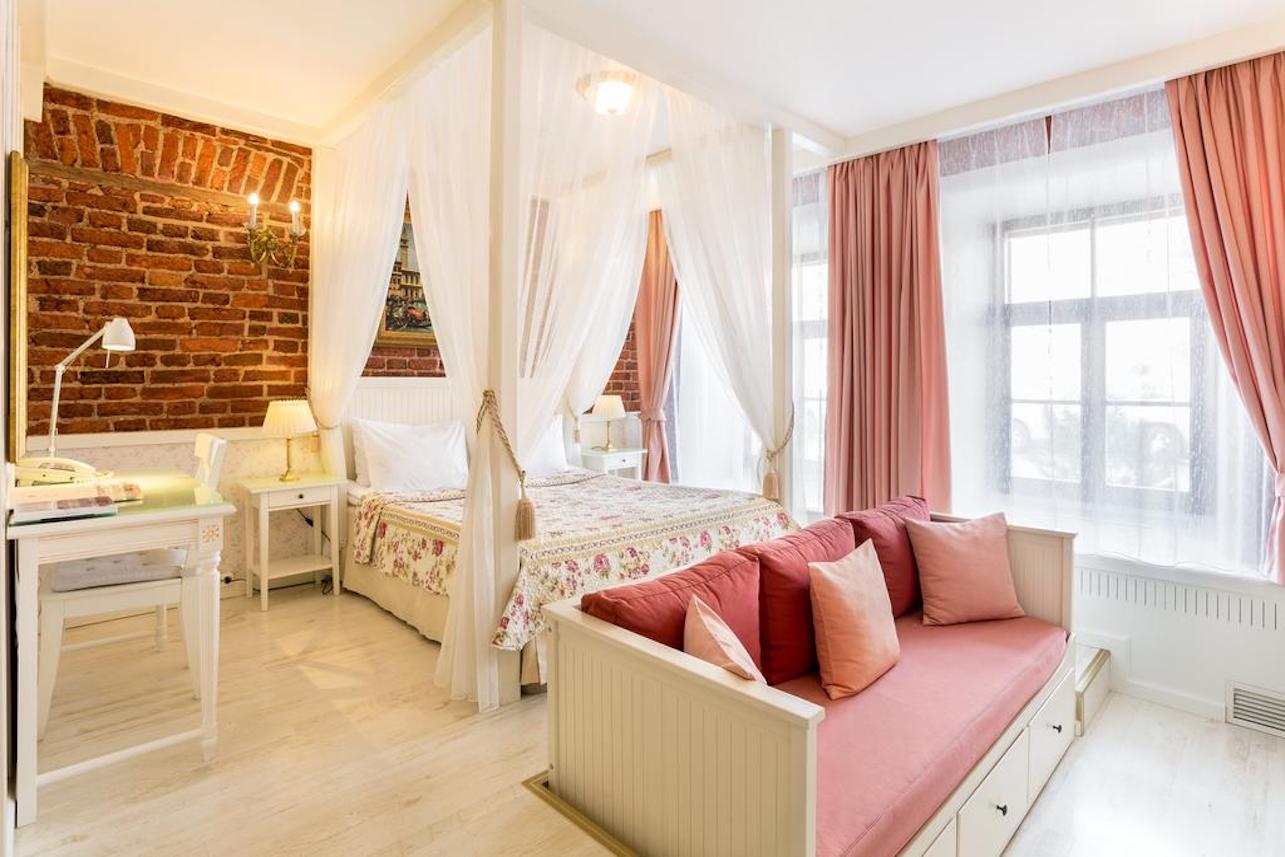
Rooms at Alexander House are inspired by the owners’ travels (Photo: Alexander House)
Another brilliant, slightly more upmarket, lodging option is Alexander House (Kryukov Kanal Embankment, 27). Once the home of a prosperous St. Petersburg merchant, today it’s a stylish boutique hotel. Each of its 20 rooms and suites is dedicated to a different city, featuring artwork and crafts from around the world. Elsewhere, there is a bar and cafe, a well-stocked library with an open fire, and a vine-covered terrace for the summer months. The place is brimming with whimsical opulence: antiques, beamed ceilings, chandeliers and framed maps. It’s located along the Kryokov Canal, a short stroll from the Mariinsky Theatre and Yusupov Palace.